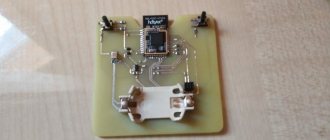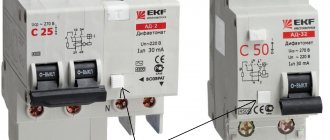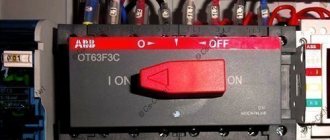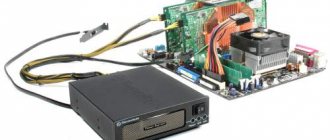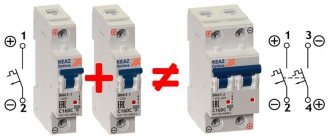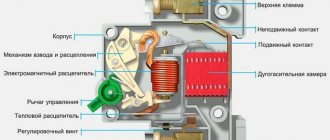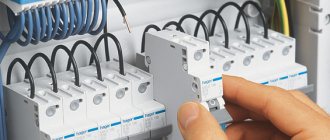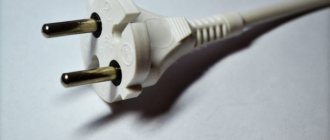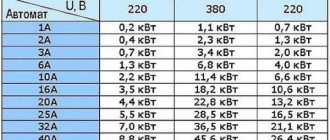Circuit breaker hums
The machine in the panel can only buzz due to an electromagnetic release that protects the line from a short circuit. It consists of an electromagnet with a movable core. The release coil is connected in series with the contacts of the device, and when the current exceeds the protection setting, the moving part of the solenoid is attracted to the stationary part, which leads to the circuit breaker turning off.
The reason why the machine hums in the panel under load is that the current in the network is alternating with a frequency of 50 Hz. This causes the coil and core to vibrate in a manner similar to the hum of mains transformers.
What else could happen if the fuse blows?
If the machine turns off, the light bulb burns out, and there is no light, no need to worry, this happens sometimes. The fact is that when a light bulb burns out, there is a temporary overload, and due to this the rated current is reduced; an AB of 6-10 A will most likely turn it off.
If the light bulb in the device burns out and the machine is knocked out, the cause of the malfunction is obvious
This does not happen with:
- Halogens;
- LEDs;
- Fluorescent light bulbs.
Often among discussions you can see a situation where the machine knocks out the stabilizer when starting. This also has its own subtleties, which are related to the functioning of the device and the inattention of the consumer. The fact is that voltage stabilizers create a current when starting up, which can increase the rated value.
This will be the reason for the shutdown.
Perhaps the stabilizer itself is faulty. Cheap products made in China are famous for their defects. If a shutdown occurs when the light is turned on, you need to check the lighting devices with a multimeter.
Why does the machine heat up?
The fact is that all household series operate on a thermomagnetic release. Under load, it heats up and as soon as the temperature exceeds the permissible value, the contact plate is deformed and activates the release mechanism, breaking the circuit.
To be fair, it should be said that all machines heat up under load and this is a normal phenomenon. The higher the load, the more the release heats up and the faster the circuit breaks. For example, if a 20A machine starts to pass 23A, then after half an hour it will turn off the network, at 25A this will happen after 5 minutes, and so on. There are several reasons for strong heating:
- Poor condition of contacts - when the contact strip is loosened, the basic throughput deteriorates, causing it to become very hot;
- Wear of the release mechanism - over time, parts wear out, their basic characteristics, including throughput, decrease;
- Poor assembly - low-quality machines, as a rule, have characteristics lower than declared. They do not pass the maximum current for which they are designed, which is why they become very hot;
- High load - the thermal release reacts to the overload protection, and it takes time to heat up, and the plastic case also heats up with it.
Each manufacturer has its own standards for permissible heating temperature, but usually it is from +55°C to +70°C, which is safe for use. You can always check the heating limit in the technical data sheet.
The machine is heating up
Hello.
When I changed the electric meter. then installed new machines. After that, when the electric kettle and washing machine were turned on, the right machine began to get very hot. The protection response rating is 25A. After the machine warms up, it turns off. Really, in terms of current, I don’t fit into 25A? Or is the reason something else? what brand of machines?
The current consumption can be estimated by measuring the electricity consumption per minute using a meter, for example.
if only the kettle and washing machine were turned on, then there was no overload. Have you noticed any heating of the wires?
andrewkhv Automatic machines IEK BA47-29 I did not notice any heating of the wires.
Thermal protection is triggered in the machine. Can you find out the nameplate power of the kettle and machine? As well as the cross-section of the line extending from the machine.
After the first operation, they tend to be cut off further for no reason. throw it away and install a C16 of some brand, even the same “brownie” VA-63 for 115-130 rubles. C25 is too much for 2.5 square copper.
Alexander60 wrote: the right automatic machine began to get very hot. The protection response rating is 25A. After the machine warms up, it turns off. Really, in terms of current, I don’t fit into 25A? Or is the reason something else?
The machine may heat up due to poor contact of the cable connections, you can tighten them, maybe due to poor contact between the moving and non-moving contacts, or due to a defect in the machine itself during manufacturing. Replace it with a Schneider electrician, and no more than 25
volchenok wrote: Thermal protection is triggered in the machine. Can you find out the nameplate power of the kettle and machine? And also the cross-section of the line extending from the machine.
Kettle - 2.2 kWh, machine _ 0.85 kWh
andrewkhv wrote:
It's okay for you to puff yourself up, I didn't take anything away from you
Alexander60 wrote: Kettle - 2.2 kWh, machine _ 0.85 kWh
Definitely 25 is too much
hammer wrote: The machine may heat up due to poor contact of connecting the cables, you can tighten them, maybe due to poor contact between the moving and non-moving contacts, due to a defect in the machine itself during manufacturing. Replace it with a Schneider electrician, and no more than 25
Schneider electrician is this company?
hammer wrote: Definitely 25 too many
I just thought there would be some extra
Alexander60 wrote: Schneider electrician is this company?
This company is called Schneider Electric - one of the world leaders in electrical engineering. Very high quality products.
hammer wrote: Definitely 25 too many
hammer, you select machines based on load, or what?
Alexander60, the machine is selected according to the cable cross-section, and you can turn on any load - the machine will work and will not allow you to burn the wiring. The machine, of course, must be in working order.
andrewkhv wrote: hammer, do you select machines based on load, or what?
andrewkhv wrote: hammer, do you select machines based on load, or what?
Alexander60, the machine is selected according to the cable cross-section, and you can turn on any load - the machine will work and will not allow you to burn the wiring. The machine, of course, must be in working order.
Well, as I understand it, if my machine is set to 25A, then the protection will work in it at a load current of 25A
Alexander60 If this current exceeds 25 A, the protection will work and the machine will turn off
Alexander60 wrote: Well, as I understand it, if my machine is set to 25A, then the protection will work in it at a load current of 25A
Alexander60, no! The characteristics of the machines are such that it can never turn off an overload of 13% (this is 28.25A), and keep it at 45% (this is 36.25A) for 1 hour! If you compare these figures with the long-term permissible current of the cable, it becomes clear that C25 cannot protect a cable of 2.5 (honest!) square copper. And if you have aluminum, then even more so.
Alexander60 wrote: Kettle - 2.2 kWh, machine _ 0.85 kWh
What kind of machine is this? I measured my previous one (Samsung). When the heater was operating, its consumption was about 2 kW. When the motor just turns, it’s 80-100W.
andrewkhv wrote: the characteristics of the machines are such that it can never turn off an overload of 13% (this is 28.25A), and keep 45% (this is 36.25A) for 1 hour! If you compare these figures with the long-term permissible current of the cable, it becomes clear that C25 cannot protect a cable of 2.5 (honest!) square copper.
Are the manufacturers lying? 1.13 - and there is a permissible long-term current for cables. There is also a 5 amp reserve.
how to treat this guest?
andrewkhv wrote: it becomes clear that there is no way to protect a cable of 2.5 (honest!) square copper C25
will protect however. if a real 2.5 is laid alone.
and the TSU advice should be set to no more than 20A
andrewkhv wrote: how to treat this guest?
Well, for example like this: " > Or like this:
523.2 The requirements of 523.1 are met if, for an insulated conductor and cable without armor, the loads are selected according to the tables in Appendix B with reference to Table A.52.3, taking into account the correction factors given in Appendix B. The permissible current loads given in Appendix B are given as recommended.
1 National committees may adapt the tables in Annex B to a simplified form for their national regulations.
NOTE 2 There is some tolerance for current carrying capacity depending on environmental conditions and the specific cable design.
If you dig deeper. Laying method:
Load: Copper 2.5 PVC
What's painted there in red? Here's what:
c) Recommended method C - position 20 of table A.52.3 (single-core or multi-core cable on a wooden wall).
The cable is mounted at a distance from the surface of less than 0.3 cable diameters. Pipes can be made of metal or plastic. When pipes are installed on masonry, the permissible current loads can be increased. This issue is under consideration.
Note 1—The term "masonry" refers to masonry, concrete, plaster, etc. (except for thermal insulation materials).
Wonderful GOST. He considers the load for a cable in a layer of plaster the same as for one laid directly on wood. And then he gives pearls about a possible increase in current loads for cables laid in pipes on a stone wall.
What to do if vibrations occur?
They often occur when current is applied to a coil or bimetallic strip, which creates an electromagnetic field that acts like an electric magnet on the metal parts inside. Electromagnetic influence provokes vibrations.
Even if the vibrations are almost imperceptible, this is also a malfunction. If you feel a slight tremor when you touch the body with your finger, it means the mechanism inside is defective, which is dangerous for further operation. In this case, it is highly recommended to make a replacement.
Purely theoretically, a circuit breaker can serve you for several more years, but there is no guarantee that the circuit will break during a short circuit. Moreover, constant vibration will over time weaken the connections more, causing the machine to jam, trigger falsely, or even fail. In any case, this is dangerous, so replace it with a new one as soon as possible. The only thing worse than vibrations is crackling. In this case, replacement is needed immediately .
Overload shutdown
First of all, it is necessary to analyze what load was connected to the electrical wiring lines that are connected to this machine. For example, a circuit breaker powers two outlets located in one of the rooms of the apartment. An electric heater was plugged into one outlet, and a vacuum cleaner was plugged into another. In this case, it is necessary to determine whether there was an overcurrent or not. To do this, it is necessary to compare the load current of household electrical appliances with the permissible load current of the circuit breaker (rated current).
The power of the electric heater is 2000 W, and the power of the vacuum cleaner is 1500 W. Having made simple calculations, we obtain the load current of these electrical appliances - 9 and 7 A, respectively, the total load in this case is 16 A. In the apartment panel, to protect the electrical wiring line feeding these sockets, a circuit breaker with a rated current of 16 A is installed.
Based on the fact that the load current does not exceed the rated value for the circuit breaker, we can conclude that there was no overload.
Otherwise, that is, if the load current is greater than the rated current of the circuit breaker, then the automatic shutdown of this device was due to overload.
It should be noted that re-closing the circuit breaker after tripping due to overload can be done a few minutes after it has been turned off. This is due to the fact that the thermal release (that element of the machine that protects against overload) is heated in the activated state, so in order for it to return to its original state it needs to cool down.
When turning off the circuit breaker, you can touch its body. If the housing is warm, this indicates that the thermal release has tripped, that is, a shutdown due to an overload in the electrical network.
Troubleshooting when a circuit breaker trips: algorithm of actions
Without a special reason, the machine will never turn off, which means that there is an emergency situation that caused the circuit to be de-energized. Therefore, before turning it on again, you need to understand why it worked, detect the problem, and fix it. Only after this can the device be put into working condition. Let's look at the two most common triggers and the troubleshooting algorithm.
The machine responsible for the line of sockets knocks out
- Immediately after the protection is triggered, all consumers should be disconnected from the sockets connected to this circuit breaker. It is worth estimating the total load that was connected. There is a possibility that there was an involuntary overload of the line. This must be taken into account, and in the future it is necessary to prevent the simultaneous inclusion of a large number of consumers.
- Turn on the machine; if the protection does not trip again, then most likely there is a line overload or a short circuit in any of the electrical appliances. If the protection device does not turn on, then we can talk about a short circuit either in the socket contacts or in the supply cable itself.
Procedure if the circuit breaker trips without load
- Inspect the sockets for burns; if any, disassemble or replace them.
- A visual inspection did not yield anything, then it is worth assuming that there was an insulation breakdown in the supply wires.
- Possible weak contact or malfunction of the machine itself. After fixing the problem or replacing it, you can try to apply voltage to the line.
Procedure if the machine turns on without load
- Turn off the protection device and connect one of the electrical appliances that was previously connected to the same outlet.
- Turn on the circuit breaker; if it trips again, then this device is faulty. If the operation does not occur, then turn on in turn all the consumers that were working before the protection was turned off. This way you can find a faulty electrical appliance.
Automatic protection is triggered, responsible for the lighting line
A fault in the lighting lines is usually detected when the chandelier is turned on. Everything is immediately clear here, but this situation does not always happen. What to do then? The algorithm of actions is simple and quite accessible to anyone:
- Switch all switch keys to “Off” mode. This de-energizes the phase wire going to the lamps.
- Unscrew the light bulbs, inspect them and the sockets - usually after a short circuit there are traces of soot on the lamp and base. Where such consequences are found, that is where the malfunction occurred. The lamp must be dismantled, the condition of the wiring and socket inspected, and replaced if necessary.
- When nothing suspicious is found on the lamps and sockets, turn on the machine. If it works again, then you should look for a short in the wiring itself. This can happen either in the junction box or anywhere along the line. The second option is that the circuit breaker has turned on, which means we move on.
- Now it’s time to turn on the lighting one by one; if the machine is triggered on some key, then you need to look for a breakdown in the wiring of this lamp.
- If after turning on the switches the protection does not work, you need to screw all the bulbs into place and try to turn on the keys one by one. This will help identify the defective bulb.
When performing any troubleshooting work, be careful and careful, because repeated short circuits are possible. If you have the slightest doubt, it is better to contact electrical specialists who have experience in such work.
AV is out of order: what to do if the plugs are knocked out
Another reason for the machine to operate is a short circuit in the electrical wiring. If the fuse has tripped due to a short circuit, you need to look for the cause. There is an effect on the phase, which in some place touches the zero, because of this a short circuit occurs and the AB protects and is instantly triggered. If electrical appliances are unplugged from the sockets and the plugs are knocked out, it is necessary to completely check the electrical wiring. This takes quite a long period of time and, in addition, you need to have the skills to find a fault, or maybe two at once. The first thing you need to do is examine all sockets and switches and check the quality of the TPG connections to the terminals. If the electrical wires are loose, the screws should be tightened.
After the sockets, you need to study the distributors. Understand that the connection of the electrical wires in them is normal, there are no bare spots that could short out. After the boxes, you need to check the lighting devices. Very often, inexperienced electricians forget to check the chandelier after the AV trips without a load. After this the light bulb burns out. It is necessary to check the reliability of the connections, as in the situation with sockets. Finally, you need to check the electrical wiring, which is usually hidden in the wall. In this case, it is correct to use a special device that will help quickly detect a short circuit. But hardly anyone at home will have it on hand, so a multimeter will help get out of the situation. Here are the reasons that turn off an electric machine and how to eliminate them.
The most rare reason, which can be the same, is a low-quality MTA machine, which kicks out due to a manufacturing defect.
You should check the machine if you are 100% sure that:
- Electrical appliances are in good working order;
- Electrical wiring is OK;
- There is no talk of overloads.
Replacing the machine with a similar one will help correct the situation; you can also replace the electric meter. This will definitely solve the problem. To avoid such a situation in the future, electricians are advised to get acquainted with the rating of the best brands of circuit breakers and select one circuit breaker and a meter from the list. It’s also a good idea to read consumer reviews. In addition to the listed reasons why the AV switched off in the electrical panel, there are also other, rare situations.
Short circuit mode
If the machine is knocked out during a short circuit, this means that an electromagnet has been activated, which serves to instantly break the electrical circuit. In this case, the wiring does not heat up to a dangerous temperature.
When the power contacts open, an electric arc appears. To prevent them from collapsing, a chamber is provided to extinguish the arc. It is made in the form of a lattice of metal plates isolated from each other. On them the arc is crushed and extinguished.
Circuit breaker arcing chamber
Before turning on the machine again after a short circuit has occurred, its causes should be found and eliminated.
The cable is heating up: causes of heating, solutions
Heating of power wires is a common cause of fires not only in production, but also in apartments. The high temperature of the conductor leads to melted insulation, and as a result, to an open source of fire. If you notice that the cable is heating up, then the cause of its heating should be eliminated immediately. This article will help in determining such a reason and bringing a household appliance to the appropriate level of electrical safety.
The main reasons for heating cables and wires
To understand the reason for the heating of electrical wiring, you need to remember the basics of electrical engineering. Electric current is the ordered movement of free electrons, in the path of which other atoms of a substance appear. A certain number of such atoms is called electrical resistance. If the resistance is too high, the temperature of the material increases.
An example of securely tightened wires
This principle is successfully applied, for example, in water heaters. In other household appliances or the electrical network, it is necessary, on the contrary, to reduce the heating of the conductors - to bring it to the nominal level.
The main reasons for heating cables and wires:
- The reason why the wire heats up is the choice of its wrong cross-section. When choosing a small cross-section of wires, which haunts almost all would-be electricians, and a constant current strength, a rapid increase in the temperature of the cable occurs. The same principle applies to water pipes - the larger the diameter, the greater the water pressure.
- Overheating of the line occurs due to improper installation. For example, a minor short circuit that does not respond to an overrated circuit breaker. The machine does not open the line - the cable continues to heat up, and after a while it burns out.
- Poor quality connection or oxidation of contacts. Aluminum wires oxidize very quickly, the connections of which should be checked more often than copper wires. In order not to worry about the quality of twisting, it is better to use special terminal blocks or carefully solder the cables.
- Using a low quality cable or wire. Now the electrical equipment market is rapidly filling with products from Korea and China, the quality of which leaves much to be desired. Such a cable, even if installed correctly, can itself cause heating and fire.
Solutions to the problem
If you notice a heating cable, then you need to know how to solve this problem. There are several popular ways to determine the problem and fix it.
Appliances
Household appliances are the main cause of overheating of the electrical network. Excessive heating of conductors occurs due to the high power of the consumer and the cable not designed for such power. But if this is not the reason, then a simple sequence will help you quickly find and fix the problem.
- Check whether the cable is equally heated along its entire length, or whether a high temperature is observed in one place. A common problem is poor electrical contact between the plug and the cable leading to the household appliance.
How to fix:
- It is necessary to unscrew the bolts securing the fork body and remove the top cover.
- Loosen the wire fastening contacts and remove the wires.
- Clean the wires and contact points - remove all obstacles to the passage of electric current. Then put the wires in their place and carefully tighten the bolts.
- The final stage is assembling the cover.
- Poor cable contact at the input of the household appliance. If the plug is intact, the quality of the contacts is at the proper level, and the wire is heating up on the other side, then you should check the distribution box (or, as it is called, the terminal box) of the household appliance.
Electrical circuit breaker malfunction
Your circuit breaker trips periodically. The probable reasons for this are as follows:
- Short circuit in the circuit;
- Network congestion;
- Damage to wires periodically leading to either a short circuit or overload.
First you need to diagnose the electrical network for overload and short circuit. If these faults are not detected, and the machine still turns off, then a malfunction of the circuit breaker itself is very likely.
Reasons why the machine knocks out
So, why does it cut off traffic jams in the apartment? The reasons may be different. Electrical overload is a common reason why a machine in a house breaks down. The fact is that this is the purpose of circuit breakers (CBs), they protect the electrical wiring from stress and further malfunction.
Calculating the total load in a circuit should not be taken lightly
Each household machine has its own rated trip current:
- 6 A;
- 10 A;
- 16 A;
- 25 A.
When several powerful appliances, chandeliers, an electric boiler, a vacuum cleaner, a washing machine, a dishwasher, whose current is higher than the rate, turn on at the same time, there is nothing strange in the fact that the circuit breaker in the house is tripped. For example, there is a 16A circuit breaker on the electrical panel. The electricity load has increased noticeably, so the circuit breaker trips and shuts down, protecting the wiring. You can find a way out, there are sure ways.
Firstly, the equipment is turned on one at a time so as not to increase the load on the network. Secondly, replacing the AV in the transformer panel with a 25 A device.
This can only be done when the electrical wiring can withstand overloads (copper, TPG cross-section not less than 2.5 mm 2). The third, most reliable one is to sort out and update the electrical wiring, which will allow you to simultaneously turn on the plug of the washing machine, dishwasher, boiler, iron, stove, etc.
The machine crackles under load
The crackling noise heard from the device always indicates the presence of sparks. Most often they occur when the moving and fixed contacts or terminals at the place where the wires are connected are worn out.
If in a working device all connections are tightly adjacent to each other, then when the connection terminals or contact group burn out, the electric current passes through soot, an air gap or point contact of conductive elements.
The flow of current through damaged areas is always accompanied by heating and further destruction of the connections, and if this process goes far enough, then sparks and the accompanying crackling noise are added to it.
Therefore, such a sound indicates the need to immediately turn off and replace the circuit breaker. Otherwise, it is possible not only for the device to fail, but also for it to catch fire and destroy the entire electrical panel.
How to protect yourself when the machine hums under load
Buy machines only from reliable brands. An economical option is an automatic machine from the manufacturer IEK. The warranty on such automatic devices is 2-5 years from the manufacturer. However, in practice they work properly for a long time.
The machine begins to buzz - this is a signal for us, it means something is wrong, it means our power grid has gone beyond the limits of normal operation
The models performed well:
- ABC;
- Eaton (Moeller);
- Hager.
Correctly select the rated current and response characteristics of the AV. For electrical appliances in which the difference between the operating and starting currents is not large, select shutdown characteristic B or C. For the most powerful devices with high starting currents (for example, an electric motor), characteristic D is suitable.
When selecting amperage, we remember the physics course from school and Ohm’s law (I=P/U). Add up the power of all electrical appliances that are turned on and divide by the electrical voltage (for a 1-phase electrical network this is 230V). The resulting figure is equal to the minimum amperage of the future machine (choose a device with the closest characteristic at a higher nominal value).
Buy from reliable manufacturers. Remember that expensive and popular models are often counterfeited. But in reality they burn, the electrical wiring heats up. Ask the seller for a certificate. Don't be afraid to ask if the seller is an authorized dealer. For example, Axiom Plus is considered a very reliable and high-quality slot machine seller. What to do if a low-quality machine is already working? Change it, and as quickly as possible.
Rumble in the building
Most often, this problem does not require any action, especially if the circuit breaker is located in a non-residential area. The reason why the machine hums is due to loose fastenings of the electromagnetic release parts, which does not affect the protective properties of the device.
If the sound coming from the case interferes with sleeping or listening to TV, then the device must be replaced. Repair in this situation is only possible by disassembling the case, which is not provided by the manufacturers.
Why are Chinese machines so unreliable?
Everyone understands that the only advantage of the “Chinese” is low cost. But it is achieved precisely by saving on materials. Budget Chinese models have cheap everything: plastic, metal, release mechanisms.
The most “trash” models often lack an arc chute. So, under high loads they do not spark, but immediately burn.
All these reductions in price will sooner or later come out sideways. For example, even due to elementary savings on rivets, the strength of the entire structure is lost. As a result, some parts fall off over time and the cocking mechanism weakens. This causes the problems listed above and will require replacement soon.
Electricians often swear at the “Chinese”. In fact, if you take the cheapest ones and take them apart to see what's inside, you'll be surprised how they even work. They usually have a lightweight design, thin springs, power contacts that barely hold, and other obvious problems. This doesn't inspire confidence.
Even worse are Chinese counterfeits of well-known brands, sold below the cost of the originals. Unfortunately, there are a lot of them on the CIS market. It is quite natural that the most popular brand, ABB, has the most counterfeits. This is a Swedish-Swiss manufacturer that produces fairly high-quality machines. Accordingly, you yourself must understand that they will not be too cheap.
To achieve high reliability and quality of releases, more expensive metals are needed: sputtering of silver, gold, etc. In addition, Europeans usually do not skimp on materials. There will definitely be an arc chute there and a heat sink will be made. And all this increases the cost, so there are no good machines cheaper than $3 .
Why do the contacts of electrical connections get hot?
One of the “weak points” of any electrical wiring, including the electrical wiring of an apartment and a house, has always been the places where electrical wires are connected and the places where the wiring wires are connected to the contacts of installation products.
The concept of “weak point” of electrical wiring means the need to pay special attention to them when carrying out electrical work here. The use of low-quality products during electrical installation, products not intended for their intended purpose, or lack of skills in electrical installation work can lead to rapid failure of household appliances, as well as emergency situations.
Danger of current
Electric current, to which we are so accustomed that we don’t even think about it, is actually a very dangerous invention of mankind. Being invisible and intangible, electric current poses a mortal threat to humans and a potential danger to the home.
The danger of electric current occurs not only in serious emergency situations, such as a short circuit or exposure of live wiring elements. There is a hidden danger of current, which manifests itself in heating, overheating and further fire of electrical wiring sections, in particular at the places of connections and connections.
What are the dangers of poor connections and connections?
Poor contact of current-carrying wires when connecting to each other and at the points of connection to devices leads to heating of the contact points. Why do the contacts get hot?
The physics of heating of poorly made contacts is explained by a simple law of two physicists, Joule and Lorentz. Let me remind you:
The heat generated is proportional to the square of the current, the resistance of the conductor and the flow time.
With good contact between two metal wiring elements, the heat generated by the current has a very specific value, which is calculated and taken into account when choosing the cross-section of conductors and the ratings of circuit breakers.
When the contact is broken, at short distances of such a violation, or, more simply put, when the contact is weakened, the resistance begins to increase, more heat is released, and the contacts begin to heat up.
Professional servicing of cash register equipment
The heating of the contacts further enhances the thermal expansion of the connection points, as a result the contact weakens even more. As a result, the contact resistance tends to almost infinity (air specific resistance 1016), heating increases.
Added to the heating of the contacts is the sparking of the contacts, which is accompanied by a colossal release of heat. As a result, burnout of contacts, burning of installation products, or, as the most dangerous option, a fire in the house.
Causes of bad contacts
Let us highlight several reasons for poor contacts in electrical wiring.
- Incorrect wire connection.
- Operational loosening of screw terminals.
- Poor quality installation product.
- Violation of connection rules.
Incorrect conductor connection
We will talk about incorrect connection of conductors in the next article. Here I note that it is preferable to use special terminal blocks to connect two conductors.
Operational loosening of screw terminals
Over time, any screw clamp that is not tightened will weaken. For electrical wiring, the recommended period for tightening contacts in switchboards is 6-8 years (departmental instructions). The same period can be applied to the wiring of contacts in sockets and switches.
The use of devices and products with non-screw connections will help to avoid pulling screw contacts. The contacts of such devices are constantly pressed by a spring.
Poor quality installation product
Poor quality of the purchased socket, switch, or protective device may be the cause of poor connection contact.
Violation of connection rules
When connecting a socket, switch, circuit breaker, you must strictly follow the connection rules. For example:
- When connecting a cable of sockets, use wires of the same cross-section for the cable jumpers. This will prevent contact distortion;
- If you need to connect wires of different sections to a contact, make rings at the end of the wires to connect to the contact. Such a connection requires the purchase of installation products with no input;
- Do not connect more wires than specified in the instructions for the device. For example, look at the Legrand outlet. The design of the socket itself says that more than two wires cannot be connected to one contact (elderly input).
Air power supply to a wooden house
Particular attention should be paid to connecting circuit breakers and protection devices. More about this here, and briefly here. If you look at the contacts of machines made by different manufacturers, we will see that there are flat contacts (for example, IEK), and there are semicircular ones (for example, ABB). Also, two-pole and three-pole ABB circuit breakers have two contact groups, one for the comb, the second for the wire. What does this mean?
- According to the manufacturer's instructions, only one wire can be inserted into a circuit breaker with a semicircular contact.
- Either one or two wires can be inserted into a circuit breaker with direct contact.
- To connect machines with a cable, it is better to use connection combs.
- Contacts on circuit breakers and protective devices must be tightened with a load according to the manufacturers' instructions. Typically, 2.8 N/m.

